Expand your SMB borrower pool with cash flow-first underwriting

Traditional underwriting processes built on credit bureau data provide a baseline for assessing risk, but they often neglect the nuanced realities of running a small business. As competition intensifies in the SMB lending market, funders are turning to new technologies and underwriting automation to grow their portfolios and serve more qualified borrowers without accumulating unnecessary risk.
Cash flow analytics has emerged as a foundational tool in this evolution. By analyzing income trends, expenses, transaction categories and financial ratios early in the underwriting funnel, SMB funders can move beyond a binary credit score and begin to qualify borrowers on the true state of their businesses. The result? Improved access to small business funding for previously overlooked entrepreneurs—and significant growth opportunities for the funders themselves.
Funding under-the-radar small businesses with cash flow-first underwriting
One common misperception in the small business lending space is that borrowers with low credit scores are inherently high risk. In reality, many SMB founders rely heavily on personal credit in the early stages, suppressing their credit scores even if the underlying business is financially sound. By focusing on cash flow patterns—such as consistent revenue inflows, stable expenses and positive net operating trends—funders can identify healthy businesses that would otherwise be disqualified through conventional credit models.
This kind of cash flow-first underwriting strategy is not only more inclusive, it’s a competitive advantage. Funders can surface a broader pool of qualified borrowers—businesses with proven operations and steady cash flow but limited or subprime credit. By adopting this approach, funders can effectively expand their borrower pool while maintaining credit discipline.
For a deeper dive into trends in small business cash flow, refer to our analysis in analytics wrapped: Trends in small business cash flow.

Smarter spending on credit bureau data
Funders are increasingly seeking ways to streamline operations and reduce costs. One area of opportunity lies in optimizing how and when they use credit bureau data. Rather than pulling credit for every applicant, funders can lead with cash flow analytics to assess borrower health early in the funnel and reserve credit bureau checks for qualified prospects.
Intelligent document processing makes this shift possible—bringing speed and structure to early-stage underwriting, technology that automates the extraction and structuring of financial data from documents like bank statements. With tools like Ocrolus, SMB lenders can analyze cash flow indicators in real time, enabling faster, more informed decisions while reducing manual work.
Funders are increasingly seeking ways to streamline operations and reduce costs. Underwriting automation, powered by cash flow analytics, presents a scalable opportunity to reinvest in borrower acquisition and growth strategies.
For a tactical perspective, see our guide on how to lower customer acquisition costs in SMB lending with cash flow analysis.

Expansion Capital Group’s cash flow-first approach
South Dakota-based Expansion Capital Group (ECG) provides a strong example of how lenders can successfully scale by implementing a cash flow-first model. ECG supports small business owners with fast, flexible capital but recognized that many of its most promising borrowers had limited credit data.
By partnering with Ocrolus, ECG was able to bring cash flow analytics and automated SMB underwriting to the top of its underwriting funnel. This enabled the funder to evaluate borrower performance using real financial signals such as NSFs, overdrafts, revenue trends and spending habits. As a result, ECG was able to filter out higher-risk applications earlier and expand its borrower pool to include businesses that might otherwise be overlooked by credit-first models.
For more insights on ECG’s approach, watch our live session Flipping the funnel: A cash flow-first approach to SMB underwriting.
Unlock more borrowers with cash flow-first underwriting
As digital lending becomes the norm, underwriting automation must evolve alongside borrower expectations. A cash flow-first underwriting approach not only improves accuracy but also enhances inclusivity by evaluating the full financial picture—not just a score.
Lenders who adopt cash flow-first underwriting can serve more small businesses, reduce acquisition costs, and grow sustainably. It’s more than a tactical shift; it’s a strategic imperative for any SMB funder looking to scale in today’s market.
Ready to expand your borrower pool? See how Ocrolus powers faster, smarter lending decisions – book a demo today.
Key takeaways
- Traditional credit-based models often miss viable small businesses that use personal credit
- Cash flow analysis for small business lending provides a 360-degree view of borrower health, from revenue patterns to debt capacity
- Funders can reduce acquisition costs by delaying credit bureau checks until later in the lending funnel
- Intelligent document automation makes cash flow underwriting scalable and cost-effective
- Organizations like Expansion Capital Group are successfully using this approach to fund more borrowers




